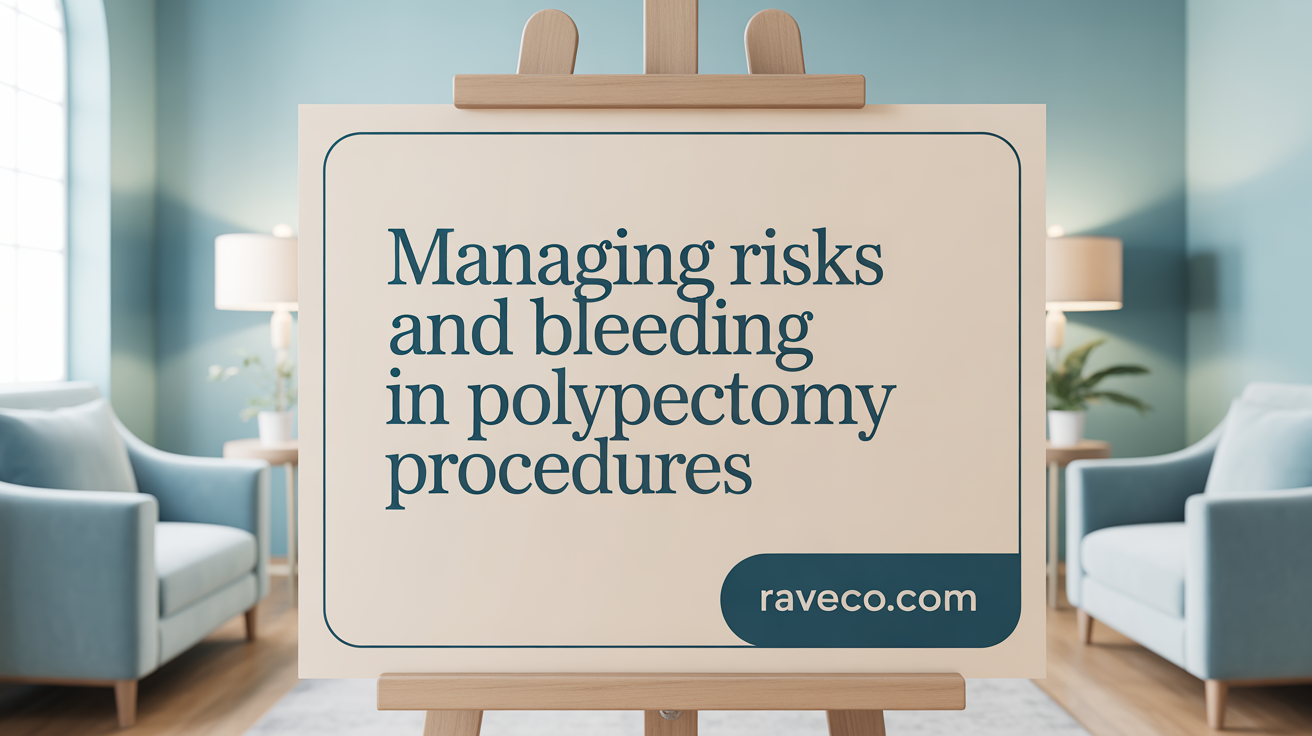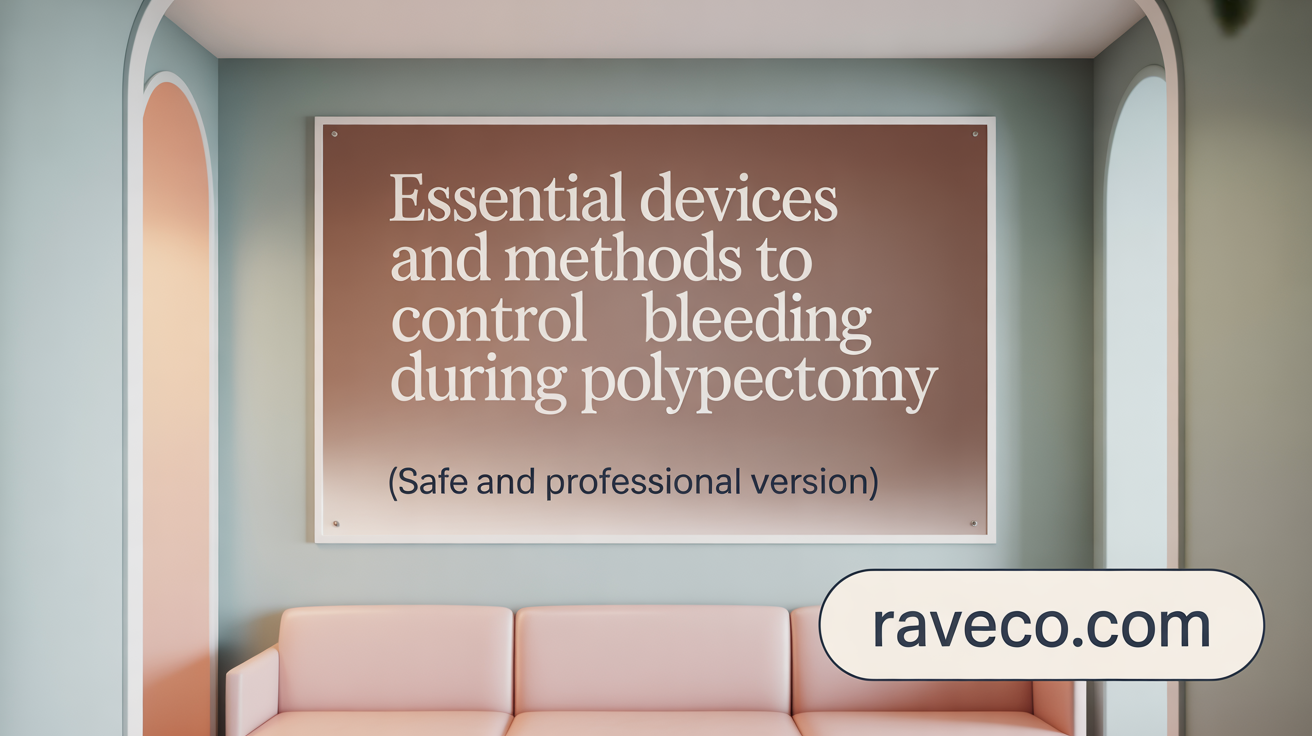Recognizing the Right Time to Address Female Infertility: Key Indicators and Expert Care in Queens

Introduction to Polypectomy and Its Clinical Importance
Polypectomy is a widely performed medical procedure focused on the removal of polyps—abnormal tissue growths that can be benign or precancerous—primarily in the colon but also in other organs such as the uterus. This minimally invasive technique plays a pivotal role in preventing cancer development and addressing symptoms caused by polyps. Despite its routine nature, polypectomy carries risks—most notably, bleeding, which may arise immediately or be delayed post-procedure. This article delves into the fundamental aspects of polypectomy, its procedures, the management of bleeding—especially persistent or delayed bleeding—and emerging advances that improve patient outcomes and safety.
What Is Polypectomy and Why Is It Important?

What is polypectomy and what is its purpose?
Polypectomy is a common medical procedure aimed at removing polyps—small growths that form on mucous membranes in various parts of the body, especially in the colon and uterus. These growths can be benign (harmless), precancerous, or potentially malignant. The main goal of a polypectomy is to remove these growths to prevent them from developing into cancer and to rule out any malignancy.
Typically performed during endoscopic procedures like colonoscopy or hysteroscopy, polypectomy is minimally invasive. It involves passing specialized tools such as snares or forceps through a scope to carefully extract the polyps. This approach allows doctors to examine the removed tissue microscopically in a lab.
By eliminating polyps early, especially those that are precancerous, polypectomy plays a critical role in reducing the risk of colorectal and other cancers. It also helps address symptoms related to polyps, like bleeding or discomfort.
Overall, polypectomy is an essential procedure in preventive medicine and early diagnosis. It enables healthcare providers to identify abnormal tissue growths before they progress to more serious conditions, making it a vital part of routine screening for organ health and cancer prevention.
Techniques and Procedures in Polypectomy: From Basic to Advanced

What techniques and procedures are used in polypectomy?
Polypectomy techniques are tailored based on the size, shape, and location of the polyp. The most common methods involve cold and hot snare techniques.
Cold snare polypectomy uses a wire loop to excise small polyps, usually less than 10 mm in diameter. This method avoids electrocautery, reducing heat-related tissue damage and bleeding risks. It is especially suited for diminutive polyps and offers a quick, minimally invasive option.
Hot snare polypectomy, on the other hand, involves passing electrosurgical current through the wire loop to cut and coagulate tissue simultaneously. This technique is preferred for larger or pedunculated polyps, typically over 10 mm, providing effective removal with cauterization to minimize immediate bleeding.
Endoscopic mucosal resection (EMR) is an advanced technique used for larger polyps, generally between 10 and 20 mm. It involves injecting a lifting solution, such as saline, beneath the lesion to create a cushion. This elevates the polyp from the underlying tissue, facilitating safer and more complete removal.
For even larger or more complex lesions exceeding 20 mm, additional procedures are employed. En bloc resection aims to remove the polyps in a single piece, often through EMR or specialized dissection methods. When this isn't feasible, piecemeal EMR is performed, where the lesion is removed in sections.
Endoscopic submucosal dissection (ESD) is a more advanced technique that allows en bloc resection of large and flat lesions, utilizing meticulous dissection of the submucosal layer while preserving tissue integrity.
Furthermore, tools like hemostatic clips and agents are used post-resection to prevent bleeding. Preparation steps such as submucosal injection of solutions help lift the lesion and reduce complications.
Overall, the choice of technique depends on the polyp's characteristics, balancing the need for complete removal with safety concerns, aiming to prevent complications like bleeding, perforation, and residual tissue.
Understanding Risks and Complications with a Focus on Bleeding

What are the risks and complications associated with polypectomy, especially bleeding?
Polypectomy, a common procedure to remove polyps from the colon or other organs, generally has a high success rate with minimal risk. However, like any medical intervention, it carries certain risks. The most frequent complication is bleeding, which can happen during the procedure (immediate bleeding) or days later (delayed bleeding). The chances of bleeding increase with larger polyps, those located in certain areas of the colon, or when the patient is on blood-thinning medications.
Most bleeding episodes are manageable during the procedure using techniques like applying clips, injections, or cautery. Immediate bleeding occurs in about 1.5% to 2.8% of cases, and delayed bleeding can affect up to 2% of patients, often within the first week. Risk factors for bleeding include polyp size, morphology, location, and patient's blood clotting status.
Besides bleeding, perforation is a serious but rare complication, happening in approximately 0.1% to 0.3% of procedures. It may result from mechanical trauma or thermal injury during electrocautery. Post-polypectomy syndrome, characterized by abdominal pain, fever, and leukocytosis without perforation, can also occur but is less common.
Infection is an uncommon complication but can occur if bacteria breach the bowel wall. Overall, smaller, cold-removed polyps pose minimal risks, whereas larger or complex procedures like endoscopic mucosal resection (EMR) or endoscopic submucosal dissection (ESD) require heightened vigilance.
Factors increasing bleeding risk
Several factors influence the likelihood of bleeding post-polypectomy. These include the size of the polyp—polyps larger than 20 mm are at higher risk—and their location, with right-sided colon polyps being more vulnerable. The technique used and the patient's clotting profile are also critical; anticoagulant or antithrombotic medication use significantly elevates bleeding risk. Procedural details such as the use of electrocautery or mechanical clipping can mitigate some of these risks.
Post-polypectomy syndrome and its manifestations
Another, less common complication is post-polypectomy syndrome, which involves deep tissue injury caused by electrical currents used during resection. Symptoms include abdominal pain, fever, and sometimes leukocytosis, mimicking perforation. However, in this condition, there is no free perforation of the bowel. Management usually involves bowel rest, intravenous fluids, and antibiotics. Restoring patient safety relies on prompt identification and treatment of these complications.
Understanding these risks allows healthcare providers to better prepare and manage patients, minimizing complications and improving overall outcomes.
Managing Persistent and Delayed Bleeding After Polypectomy

When does bleeding typically occur after a polypectomy, and how common is it?
Bleeding after polypectomy can happen immediately or be delayed, sometimes occurring up to 30 days post-procedure. Immediate bleeding is observed in about 1.5% to 2.8% of cases, often manageable with endoscopic techniques. Delayed bleeding, the most common adverse event, occurs in up to 2% of patients, with an incidence ranging from 0.2% to 7%. The timing of bleeding influences the management approach, with immediate bleeding generally occurring during the procedure, while delayed bleeding might happen days later and requires vigilant follow-up.
How is persistent or delayed bleeding managed after polypectomy?
The primary method for managing bleeding after polypectomy is endoscopic intervention. For immediate bleeding, techniques such as applying pressure, injecting epinephrine, cauterizing the bleeding vessel, and deploying hemostatic clips are most effective. In cases of delayed bleeding, similar endoscopic methods—like thermal coagulation and clip placement—are used to achieve hemostasis.
Prophylactic measures help reduce the risk. For large or high-risk lesions, prophylactic clipping of the polypectomy site has been shown to decrease delayed hemorrhages, especially in patients on antithrombotic therapy. While this is not universally recommended, targeted prophylaxis is beneficial in high-risk scenarios.
In severe cases where the bleeding is persistent and the patient becomes hemodynamically unstable, resuscitative measures such as fluid replacement, blood transfusions, and stabilization are critical before definitive treatment. Emergency surgical intervention is rarely needed but can be considered if endoscopic methods fail.
Emerging adjuncts include topical hemostatic agents such as PuraStat, a mucoadhesive gel that rapidly gels upon deployment and contains epinephrine nanoparticles. These agents are promising alternatives, especially in difficult cases where conventional methods fail.
Using colonoscopy for diagnosis and treatment
Colonoscopy remains the gold standard for both diagnosing and managing post-polypectomy bleeding. During the procedure, the endoscopist can identify bleeding sources, assess the risk factors, and immediately apply treatments. The ability to perform targeted interventions such as clip placement, thermal therapy, or injection makes colonoscopy indispensable.
Further diagnostic tools like bleeding grade assessments and risk stratification scales (e.g., Oakland score) assist clinicians in planning the appropriate management approach.
How is severe bleeding stabilized and controlled?
Severe bleeding requiring stabilization involves a combination of resuscitative efforts and endoscopic control. Immediate priorities are maintaining airway, breathing, and circulation (ABCs), administering IV fluids, and performing blood transfusions if necessary.
Once stabilized, urgent colonoscopy is performed. Endoscopic techniques as mentioned include clipping, thermal coagulation, and topical hemostatic powders. In cases where colonoscopy cannot control bleeding, interventional radiology with angioembolization provides an alternative for definitive hemorrhage control.
Overall, prompt recognition, risk assessment, and the use of effective endoscopic hemostatic tools are vital in managing persistent and delayed bleeding after polypectomy, minimizing patient morbidity and preventing adverse outcomes.
Devices and Methods Used to Prevent and Control Bleeding During Polypectomy

What medical devices or methods are used to prevent or control bleeding during polypectomy?
Managing bleeding during and after polypectomy involves a variety of tools and techniques designed to ensure patient safety and procedure success. One of the most commonly used devices is the application of hemostatic clips, such as the Assurance® Control Clip. These clips are deployed through the endoscope to mechanically close bleeding vessels or secure mucosal defects, especially for larger or more vascular polyps.
In addition to clips, injection of medications to constrict blood vessels is frequently employed. Epinephrine injections can cause vasoconstriction, reducing bleeding risk during the procedure. Often, epinephrine is combined with submucosal lifts created by viscous solutions like ORISE Gel, which elevates the polyp and provides a buffer zone to prevent deep tissue injury and bleeding.
Thermal cautery devices are another critical tool. These include bipolar probes or thermal electrodes that coagulate blood vessels using heat. They are especially effective in achieving hemostasis when visible bleeding occurs.
Emerging technologies are expanding the options for bleeding control. Hemostatic gels, such as PuraStat, form a physical barrier over bleeding sites and contain components like epinephrine nanoparticles, which provide prolonged vasoconstriction and promote healing. These gels are applied directly via endoscope channels and can be particularly useful when other methods are insufficient.
For prophylactic purposes, devices like detachable loops or band ligators are used, especially in pedunculated polyps with thick stalks. These tools help mechanically occlude vessels and reduce the risk of bleeding during removal.
Together, these devices and techniques form an integrated approach to ensure bleeding is effectively managed, minimizing complications and improving patient outcomes during polypectomy.
Indications and Role of Polypectomy in Different Health Conditions and Organs
What Are the Common Reasons for Performing a Polypectomy?
Polypectomy is primarily performed to remove polyps that are found during routine screenings or when patients experience symptoms. In the colon, polyps are often detected during colonoscopy screening for colorectal cancer, especially in individuals over the age of 50 or those with a family history of colorectal cancer. People may also undergo polypectomy if they experience symptoms like rectal bleeding, abdominal pain, or changes in bowel habits.
In the uterus, endometrial polyps are usually discovered when women experience abnormal vaginal bleeding, such as heavy periods, spotting between cycles, or bleeding after menopause. Removing these polyps can help alleviate symptoms and assess for possible precancerous changes.
How Is Polypectomy Performed in Different Organs?
In the colon, polypectomy is most often done via colonoscopy, using tools like snares or forceps passed through a flexible endoscope. Techniques may include cold snare, hot snare (electrocautery), or advanced methods like endoscopic mucosal resection (EMR). These methods allow for minimally invasive removal, often on an outpatient basis.
For uterine polyps, hysteroscopy is the standard procedure. It involves inserting a small telescope through the vagina and cervix into the uterus to visualize and carefully remove the polyp with grasping forceps or a resectoscope. This approach ensures accurate removal and tissue sampling.
What Is the Impact on Fertility and Symptom Relief?
Removing endometrial polyps can significantly improve fertility outcomes, particularly in women facing difficulties conceiving. Polyps can interfere with embryo implantation and increase miscarriage risk. Their removal often leads to enhanced chances of pregnancy.
In the colon, polypectomy can prevent progression to colorectal cancer and relieve symptoms such as bleeding or discomfort, thereby improving quality of life. Regular screening and removal of precancerous polyps have been proven to reduce colorectal cancer rates.
What Factors Influence Clinical Decisions?
Deciding to perform a polypectomy depends on several factors, including the size, number, and appearance of the polyps, as well as patient health, age, and risk factors. For example, larger polyps or those with suspicious features warrant removal and closer follow-up. Additionally, in patients on blood-thinning medications, careful planning around the procedure is necessary to balance bleeding risks and clot prevention.
In summary, polypectomy is a vital procedure utilized across different organs to diagnose, treat, and prevent potential malignancies, while also improving symptoms and reproductive health. Tailoring the approach to individual patient needs ensures optimal outcomes and safety.
Recovery Process and Typical Outcomes After Polypectomy
What is the recovery process and typical outcomes following polypectomy?
Recovery from a polypectomy is usually swift and uneventful. Most patients report mild discomfort, such as cramping or tenderness, and light bleeding immediately after the procedure. These symptoms generally resolve within 24 hours, making it a minimally invasive process.
The healing timeline for the site of polyp removal can extend up to two weeks. During this period, patients are advised to avoid heavy lifting, vigorous exercise, and foods or beverages that can irritate the gastrointestinal tract, such as spicy foods, alcohol, and caffeine.
Common post-procedure symptoms include minor cramping, tenderness, and occasional bleeding. While these are typically manageable, any severe or persistent symptoms—such as heavy bleeding, severe pain, fever, or signs of infection—should prompt urgent medical consultation.
Follow-up care includes monitoring for any signs of complications. Depending on the pathology of the removed polyp, healthcare providers recommend surveillance colonoscopies at intervals ranging from three to five years. More frequent examinations may be necessary if multiple or large polyps are removed.
Overall, the outlook following a polypectomy is very positive. For benign lesions, the risk of long-term complications is low. The procedure effectively reduces the risk of colorectal cancer and alleviates symptoms when present.
Most patients can expect full recovery within a couple of weeks, with minimal impact on their daily activities. With proper follow-up and care, the prognosis remains highly favorable for most individuals undergoing this common and safe procedure.
Preventing Further Health Issues: The Significance of Polypectomy
What is the significance of polypectomy in preventing further health issues related to polyps?
Polypectomy plays a vital role in safeguarding health by removing growths called polyps that develop in the colon and other organs. While most polyps are benign, some can grow or change into cancer over time if left untreated.
Removing these polyps during a colonoscopy helps to prevent the progression to colorectal cancer, which is a leading cause of cancer-related deaths worldwide. Multiple studies have shown that patients who undergo polypectomy experience a significant reduction in cancer incidence.
This procedure not only removes existing risky tissue but also allows for microscopic analysis to identify precancerous changes. Regular screening and surveillance after polypectomy help detect any new or residual polyps early, further reducing the chances of malignant transformation.
In essence, polypectomy is a minimally invasive approach with high effectiveness in reducing the burden of cancer and improving long-term health outcomes.
Role in cancer risk reduction
Removing polyps before they turn cancerous is one of the most powerful tools in colorectal cancer prevention. It intercepts the disease at its precancerous stage, drastically lowering cancer incidence.
Impact on colorectal cancer mortality
Effective polypectomy protocols have been correlated with a decline in colorectal cancer deaths. By catching and removing polyps early, the progression to invasive cancer is prevented, thus improving survival rates.
Importance of regular screening and surveillance
Continuous screening programs enable early detection of new polyps, ensuring they are treated promptly. Follow-up colonoscopies are critical, especially for patients with a history of sizable or multiple polyps.
Benefits beyond cancer prevention
Beyond reducing cancer risk, polypectomy alleviates symptoms such as bleeding and discomfort caused by larger polyps. It also provides diagnostic insights, guiding further treatment or lifestyle changes to maintain colon health.
| Aspect | Benefit | Additional Details |
|---|---|---|
| Cancer risk reduction | Significant decrease in colorectal cancer | Polypectomy cuts down the chances of malignant transformation |
| Mortality impact | Lower death rates from colorectal cancer | Early removal of precancerous polyps prevents progression |
| Screening importance | Early detection of new polyps | Regular surveillance catches recurring or new lesions |
| Other health benefits | Symptom relief and health monitoring | Removes large or problematic polyps, provides diagnostic info |
Advanced Developments and Future Directions in Polypectomy and Bleeding Management
Emerging techniques like EMS
Endoscopic mucosal stripping (EMS) represents a significant improvement in polypectomy. It mechanically removes polyps by stripping the mucosa, reducing damage to submucosal vessels and lowering bleeding risks. Retrospective studies show EMS can almost eliminate postprocedural bleeding, with no hospitalizations related to bleeding during its use. It also enables more complete removal of advanced polyps, decreasing residual and recurrent lesions.
New hemostatic agents and gels
Innovations like 'epi-gel', a mucoadhesive gel containing epinephrine nanoparticles, are promising in controlling bleeding after large polyp removal. Its ultrafast gelation sticks immediately to tissue, last up to 72 hours, and promotes healing. This addresses limitations of current options like clips and surgical glue, especially in challenging cases.
Role of prophylactic clipping and cost-effectiveness
Prophylactic clipping of large or high-risk polyps, particularly ≥20 mm in the proximal colon, significantly reduces immediate post-polypectomy bleeding. Cost-effectiveness analyses support targeted clipping primarily for high-risk lesions, with the number needed to treat around 23 patients. However, universal clipping for all lesions has limited benefit and may not be justified, emphasizing tailored approaches.
Balancing antithrombotic management and bleeding risk
Managing patients on blood thinners remains complex. Temporary interruption of drugs like clopidogrel or DOACs before polypectomy can lower bleeding risk without significant cardiovascular danger. Continuing aspirin is generally safe, while careful timing of drug resumption post-procedure is crucial. Strategies like heparin bridging are usually avoided due to higher bleeding risks. Personalized protocols, considering individual risk factors, are essential for optimal outcomes.
Summary and Outlook on Polypectomy in Bleeding Management
Polypectomy remains a cornerstone procedure in modern medicine, principally for its effectiveness in removing polyps that may otherwise progress to malignancy. While bleeding is the most common complication, advancements in endoscopic techniques and hemostatic devices have significantly improved safety and outcomes. Persistent or delayed bleeding, once a major concern, is now increasingly manageable with a variety of endoscopic interventions such as clipping, cautery, and emerging hemostatic gels. Targeted prophylactic strategies, especially for high-risk polyps, and individualized patient management, including antithrombotic drug considerations, further optimize safety. As innovations like endoscopic mucosal stripping and novel mucoadhesive gels enter clinical practice, the future promises safer, more effective polypectomy procedures. Continuous surveillance and research remain essential to refine techniques and promote patient wellbeing, ensuring polypectomy’s lasting impact on preventing colorectal and other cancers.
References
- Polypectomy: Definition, Preparation, Procedure & Recovery
- How Do I Manage Post-Polypectomy Bleeding? - PMC
- Postpolypectomy Bleeding Prevention and More Complete ...
- Polypectomy - an overview | ScienceDirect Topics
- The Role of Clips in Preventing Delayed Bleeding After Colorectal ...
- Delphi consensus statement for the management of delayed post ...
- Establishment of a model for predicting delayed post-polypectomy ...
- The Importance of Endometrial Polyp Removal - Audubon Fertility
- Post-polypectomy colorectal bleeding: current strategies and the ...





.png)